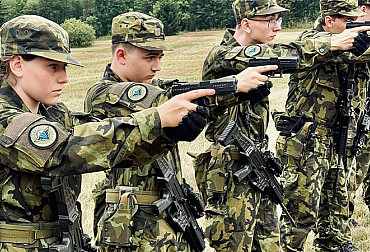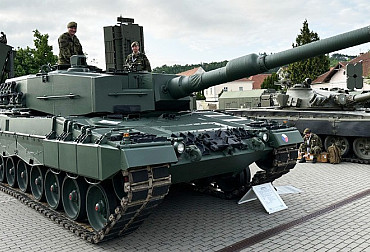The new Venom and Viper helicopters for the Czech Army will get a camouflage from the VHU workshop
"With my work I try not to give the viewer's eye anything for free and I admit that I enjoy provoking a bit with my work," academic painter Pavel Holý from the Military Historical Institute in Prague (VHU) says. If you look at his paintings, you have to agree with him. His works will force you to involve the brain in addition to sight, and you say to yourself that it's not possible. Is it there or not. After a detailed look, you will find that it is real. Creating illusions is his domain. Perhaps also because of his characteristic work, he was approached years ago by representatives of the Air Force of the Czech Armed Forces, and thanks to his concepts, the Czech military fleet is proud of its attractive coloring of the Czech military aircraft.
 Picture: The new Venom and Viper helicopters for the Czech Army will get a camouflage from the VHU workshop / CC BY-NC-ND
Picture: The new Venom and Viper helicopters for the Czech Army will get a camouflage from the VHU workshop / CC BY-NC-ND
In the past, academic painter Pavel Holý participated, for example, in the project of very elegant and effective coloring of the A319CJ, CL601 Challenger or L-410UVP-E aircraft of the Government Squadron in gray-silver coating with a metallic effect, operated by the 24th Air Force Base in Prague Kbely. Also the design of a special camouflage of the L-159 Alca aircraft, reminiscent of the Spitfire Mk Vb of Major General František Peřina, on which Major Marek Pažúr from the 21st Tactical Air Force Base in Čáslav collaborated, comes from his workshop. Now he will be signed under the final design of new helicopters of the Army of the Czech Republic.
The goal is to deceive the enemy
The newly acquired helicopters, ie eight multi-purpose UH-1Y Venoms and four attack AH-1Z Vipers, which will be delivered to the Czech Army, have a color that is not suitable for our conditions. Therefore, it was necessary to create a suitable camouflage for them. Representatives of the Army therefore went to the workshop of the Military Historical Institute in Prague. "When I received the offer to create a concept for a new attractive camouflage scheme for Czech military helicopters, I admit that it was an amazing challenge, combined with great responsibility. It's not that you can scribble an airplane the way you like it, because there are some rules for military combat planes. The main goal is not only to deceive the enemy, but basically to make the aircraft invisible, and thus safe for the crew," Pavel Holý recalls.
 Picture: The main goal is not only to deceive the enemy, but basically to make the aircraft invisible, and thus safe for the crew. | VHÚ Praha / CC BY-NC-ND
Picture: The main goal is not only to deceive the enemy, but basically to make the aircraft invisible, and thus safe for the crew. | VHÚ Praha / CC BY-NC-ND
His final design was preceded by six months of hard work, when he studied in detail the camouflage of helicopters of other armies of the world. "We have to assume that the biggest threat to helicopters is mostly on the ground, not in the air. The threat from the air, which is a fighter plane, observes the helicopter with radar, and in this case it is completely irrelevant what color the helicopter has. Whatever color it is, it will never become completely invisible. However, if you follow certain rules, use angled or muted colors, in our case colors that have a gray-brown, but also a slight purple tinge, put bright colors on the edges of the machine silhouette and darker in the middle, the silhouette from a greater distance begins to blend with the background and will appear less contrasting. Camouflage schemes are also evolving. If the Air Force uses multicolored camouflage, in recent years, development has led to the maximum breaking of the silhouette of the aircraft. The individual camouflage fields have very different sizes and there is a significant effort to suppress any regularity," Holý explains.
Three shades of gray and one of green
American Venom and Viper helicopters will get classic NATO Standard camouflage for Central European conditions. "It's three shades of gray and one shade of green. The colors comply with the Czech Army Air Force regulations and these shades are already applied to W-3A Sokol, Mi-17/171 helicopters or Casa C-295M and L-410UVP-E20M aircraft. So you couldn't experiment much in colors. However, what will be different from our previous Mi-24 and Mi-17 helicopters is the shape of the camouflage fields. But even so, it was not just a white canvas for free creation, and in addition to the fact that the helicopter will look nice, you must also think about the safety and protection of the entire crew," the academic painter continues. "The gearbox cover and tail section are the same for both Venom and Viper helicopters. Therefore, they have identical camouflage in these parts. What they have different is the middle and front of the torso. It is therefore necessary to apply light colors at the ends of the silhouette, so that it blends in better with the surrounding light sky during the flight,” Holý explains. When the final design was made, Pavel Holý had to think about many details that are not obvious to the viewer at first glance. “A specific thing on the UH-1 helicopters of all versions is the side door. The camouflage field at the sliding door and the rear of the fuselage of the UH-1Y Venom must merge into one field when the door is opened.
 Picture: A specific thing on the UH-1 helicopters of all versions is the side door. The camouflage field at the sliding door and the rear of the fuselage of the UH-1Y Venom must merge into one field when the door is opened. | VHÚ Praha / CC BY-NC-ND
Picture: A specific thing on the UH-1 helicopters of all versions is the side door. The camouflage field at the sliding door and the rear of the fuselage of the UH-1Y Venom must merge into one field when the door is opened. | VHÚ Praha / CC BY-NC-ND
The helicopter can be in the air even with the door open, and if the camouflage fields did not follow each other in this case, this detail could make it more difficult for the crew to perform the task. Light colors are not used around the windows, which are very dark when viewed from the outside and would create too much contrast, "says Pavel Holý, looking back at the approved camouflage proposal, which has already been approved by the Department of Military Aviation Supervision (ODVL SDK MO).
Paul enjoys the illusion
The new helicopters with camouflage from the workshop of the Military Historical Institute in Prague will have their home base in Náměšť nad Oslavou at the 22nd Sedlec-Vícenice helicopter base. "I confess I have a wonderful feeling. The work was very demanding, but it got under my skin and I really enjoyed it. Who has that canvas for him to wade through the sky among the clouds. In my paintings, I try to convince the viewer that there is something that is not really there. Here I had to reverse the process - we try to convince the enemy that something that is really there, does not exist," the author of the approved proposal smiles.





















